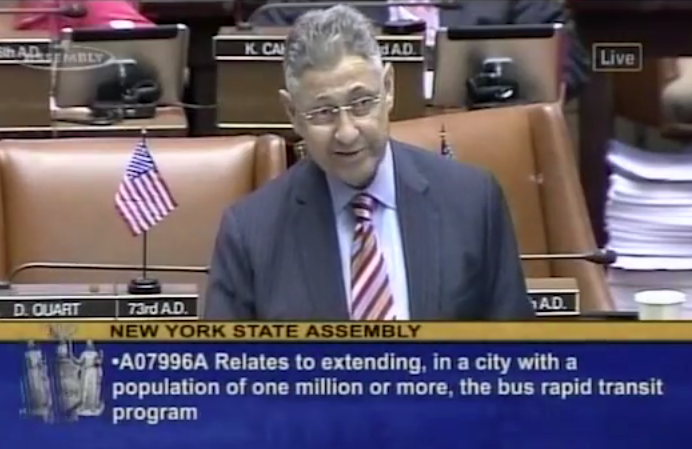Update 10:06 p.m.: The story has been updated to reflect the final official vote tally in the Assembly of 79-60. Tonight, the Senate passed its companion bill with an unofficial vote tally of 51 in favor and 8 opposed.
The bill to preserve and expand the use of NYC's bus lane enforcement cameras squeaked by in a rare contested vote in the Assembly yesterday afternoon. Former speaker Sheldon Silver, who represents Lower Manhattan, sided against the bill, but it mustered only a few votes more than the minimum needed to pass and now goes to the State Senate.

The bill, sponsored by Queens Assembly Member Nily Rozic, would extend camera enforcement of bus lanes in New York City for another five years and expand the program from a maximum of six routes to as many as 16. In the Assembly, 76 votes are needed for a bill to pass, and Rozic's bill garnered 79 votes to 60 against.
The Senate version is sponsored by Brooklyn Republican Martin Golden. Without action from the Senate, the enforcement program will expire on September 20.
Silver, whose district is served by the camera-enforced M15 bus, urged members to vote against the bill. "I think this clearly is a revenue enhancer for the City of New York and nothing else," he said on the floor of the Assembly. "It is a trap for motorists."
Silver led the Assembly when it first rejected bus lane cameras in 2008 and when it finally approved a limited program for New York City in 2010. Yesterday, he objected to the expansion of the program under Rozic's bill, which would allow the city to use the cameras on 10 additional bus routes of its choosing.
With any NYC bus lane eligible for camera enforcement, bus riders on some of the busiest routes in the city could get faster trips. The Fifth Avenue bus lane, for instance, carries 90 buses per hour during the morning rush and transports 78,000 people each day, according to stats Transportation Commissioner Polly Trottenberg cited on the Brian Lehrer Show this morning.
Silver was also not pleased that cameras would be allowed on streets with fewer than two car lanes, claiming that drivers going around double-parked cars would have no choice but to enter the bus lane and get a ticket. (Silver didn't mention that bus lanes, which are almost always along the curbside or offset from the parking lane, are where people would illegally park if not for camera enforcement.)
Also opposing the bill was Republican Nicole Malliotakis, who has worked with other Staten Island officials to oppose bus lane enforcement. “I’m one of the ones who has complained most about the cameras, and we have been successful in getting some of them removed," she said. “I think that the City of New York has utilized this program to set up these traps for people.”
In fact, bus lanes have played a key role in speeding bus trips: On 125th Street, local buses -- which don't benefit from off-board fare collection and limited stops like Select Bus Service -- are moving up to 20 percent faster on camera-enforced bus lanes.
Staten Island Democrat Matthew Titone, who also opposes bus lane enforcement, followed Malliotakis and Silver. “I can’t believe I have to speak after Mr. Silver and Ms. Malliotakis agreed with each other," he said to laughs from the chamber. “Where the heck am I?"





